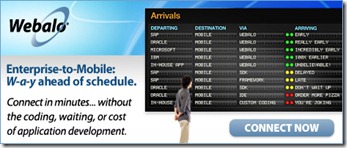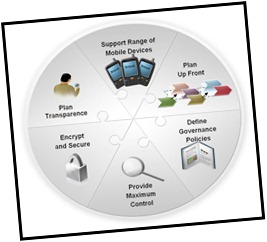 |
| ClickSoftware's Israel Beniaminy |
Note: Israel responded in writing to my questions and then we followed up with a phone interview.
Kevin: What are your current roles and responsibilities? How long have you been in these roles?
Israel: I am Senior VP of Product Strategy at ClickSoftware. Informally, I describe this role as managing the process in which innovation ideas are created, gathered, researched, refined, selected and converted into concrete business plans. I have served in this and prior roles bridging between business and technology at ClickSoftware for the past eight years. Before that I served in more technical roles, and under pressure I will admit to still being a technologist at heart.
Kevin: Where are you located? How long have you been in that area?
Israel: During most of my professional career I have been based in Israel, including my current location at ClickSoftware's Israeli office, in Petach Tikva (near Tel Aviv).
Kevin: What mobile device(s) do you carry?
Israel: This tends to change quite often. Current snapshot: Main workhorse is Lenovo X200 laptop – e-mail, research, development, writing, etc. Blackberry Bold for voice and short e-mails; iPod Touch for music and reading e-books (the small size still makes for surprisingly convenient reading, and you can't beat its size and weight for portability). iPad for Internet browsing, some more e-mail (is that a recurring theme?), reading e-books and some games.
Kevin: What are some of your favorite mobile applications that you have on your mobile device?
Israel: As a voracious reader, I love the e-book readers, switching between Kindle App, Stanza and iBooks according to the e-book type and source. Apart from these, I have LinkedIn, Facebook and Twitter apps on all my mobile devices. My favorite navigation app is Waze – it works well, has good traffic reports, and it is so impressive that they got all that via crowd sourcing. Games come and go – one game I liked recently is Tower Madness.
Kevin: Do you ever use your mobile device to buy things?
Israel: Yes. Mostly e-books and applications.
Kevin: How many computing devices do you have in your home?
Israel: Depends on how you count. My wife, son and daughter each have a desktop. We also have a netbook but have been using it less since a lot of the things it can do are better on an iPad or iPod, or on my son's Motorola Milestone (Android mobile device). We also have several iPod Touch devices, gaming machines – Wii, PSP, and soon to add a living-room media computer.
Kevin: How long have you been involved in enterprise mobility?
Israel: For at least a decade now.
Kevin: How did you get involved in enterprise mobility?
Israel: Working on field service solutions, it was very natural to think of how to communicate with the field service engineers. I remember one customer of ours, a service organization, whose service engineers worked out of remote locations and didn’t start each day at the office. I think it was around 1995, when mobile data was very expensive and not too reliable, so the solution they came up with was to send each technician a fax with the next day's scheduled tasks. The technicians would report the task execution by filling in paper forms and faxing them back to the main office. Combine this with the complete inability to know where your workers are during the day, and you must find yourself thinking: "there must be a better way!" So we started out by integrating our scheduling and routing solutions with mobile solutions developed by partners, even when only a minority of field workforces were mobilized. Later, we saw that connecting to the field service management and scheduling system was a prime driver for mobilizing, and that mobility had to be tightly interwoven into the service task life cycle, so we developed our own mobility solutions.
Read Part 2 of this interview.
Read Part 3 of this interview.
Read Part 4 of this interview.
Whitepapers of Note:
- ClickSoftware Mobility Suite and Sybase Mobility Solution
- The Business Benefits of Mobile Adoption with SAP Systems
- Networked Field Services
- Mobile, The Next Big Thing for Business
Kevin Benedict, Independent Mobile and M2M Industry Analyst, SAP Mentor Volunteer
Follow me on Twitter @krbenedict
Join the SAP Enterprise Mobility Group on Linkedin
Read The Mobility News Weekly
Read The Mobile Retailing News Weekly
Read The Field Mobility News Weekly
Read The Mobile Money News Weekly
Read The M2M News Monthly
Full Disclosure: I am an independent mobility analyst, consultant and blogger. I work with and have worked with many of the companies mentioned in my articles.


























